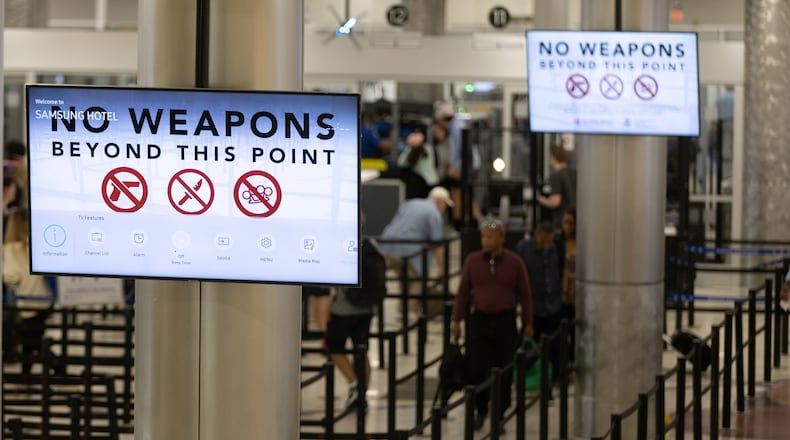The Transportation Security Administration (TSA) reported that it intercepted 6,678 firearms at airport security checkpoints in 2024 (or around 18 per day), with 94% loaded. This is a drop from 6,737 firearms intercepted in 2023. The nation’s leader was Atlanta Hartsfield Jackson International Airport. with 440 firearms intercepted in 2024, down from 451 in 2023. Given that the number of travelers jumped by more than 5%, the firearm detection rate (measured per 1 million passengers screened) dropped by nearly 6%. For air travelers, is this news to celebrate or an issue of concern?
On one hand, this might be because a fewer number of firearms were purchased in 2024 compared to 2023, 2022, 2021 and 2020. On the other hand, if people are attempting to pass the same number of guns through airports security checkpoints, then catching fewer firearms might raise a red flag on the effectiveness of the screening procedures.
Credit: Handout
Credit: Handout
The TSA does not report the number of firearms missed. Of course, if you miss something, how would you know that you missed it? One way to estimate this is by looking at whether the people found with a firearm are on the originating or returning part of their flight itinerary. If they are on the returning part, they likely had the firearm with them on their originating flight as well.
The TSA has made substantial investments in new CT technologies designed to more effectively find threat items that people carry with them in their carry-on bags. These technologies take a 3D scan of a bags content, rather than a 2-D scan that the X-ray machines that they replaced provided. The hope is that CT scanners are reducing the number of missed threat items, including firearms.
The TSA permits people to travel with firearms and ammunition in their checked bag, with well-defined procedures and precautions. The issue only becomes problematic when passengers attempt to bring a firearm with them in their carry-on bag.
The difference in the numbers between 2024 and 2023 is sufficiently small that it is impossible to explain. It would require several years of such observational data to support any explanations as to its cause.
The ideal numbers of firearms intercepted at airport security checkpoints would be zero. This would occur when no one brings a firearm to a checkpoint, hence there are no firearms for the TSA officers to intercept. Of course, that is highly unrealistic to expect. With nearly 400 million firearms in the nation, the likelihood that there are some people who regularly carry a firearm on them forget to leave it at home before taking their flight is quite high. This is also the most frequent reason that travelers give when found with a firearm at an airport security checkpoint.
The TSA posts highly visible signs at the entrance of airport security checkpoints alerting travelers that firearms are not permitted in carry-on bags. It also posts the associated penalties if caught, with the maximum penalty currently set at $14,950. Despite all such efforts, firearms continue to show up at airport security checkpoints. Clearly, such signs and penalties are inadequate to meaningfully reduce the firearm numbers.
Though the number of firearms is relatively small (around 18 per day across more than 400 federalized airports and with about 2.5 million passengers being screened), when they are found, they create disruption at airport checkpoints, with law enforcement officers engaged to address the issue. Even when the passenger claims that he or she forgot about the firearm in a carry-on bag, everyone who is attempting to pass through the checkpoint at that time is affected.
Given that more than one-third of the firearms intercepted were at 10 high-volume airports in states with permissive firearms laws (Georgia, Texas, Florida, Colorado, Arizona and Tennessee), risk-based security suggests that these airports require even greater attention to inform flyers from their airports that firearms are permitted in checked, but not in carry-on bags. This could include triage at the beginning of the lines into these 10 airports’ checkpoint areas asking people if they have a firearm on them or in their carry-one bag. Such a person-to-person interaction could significantly reduce the number of firearms intercepted at these airports, with travelers directly reminded about the issue.
Of course, even with 6,678 firearms intercepted in 2024, and especially for those missed, the good news is that nothing occurred that led to acts of violence within the air system. This should be the end measure for the effectiveness of the TSA.
Passengers should feel confident that the number of firearms detected at airport security checkpoints by the TSA is not an effective measure for how well or poorly the TSA is doing its job. It is likely more indicative that we live in a society where firearms are ubiquitous.
Sheldon H. Jacobson is a professor in computer science in the Grainger College of Engineering at the University of Illinois Urbana-Champaign. He has researched risk-based aviation security for more than 25 years.
About the Author
Keep Reading
The Latest
Featured



